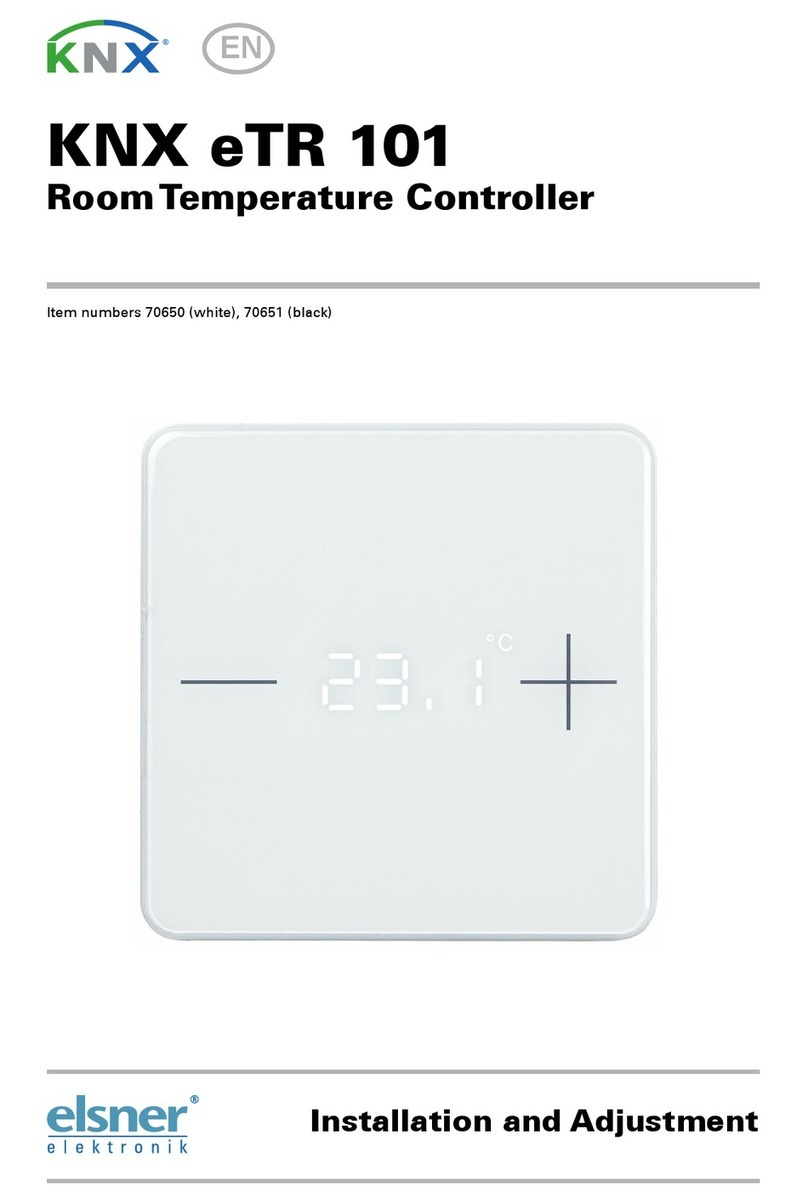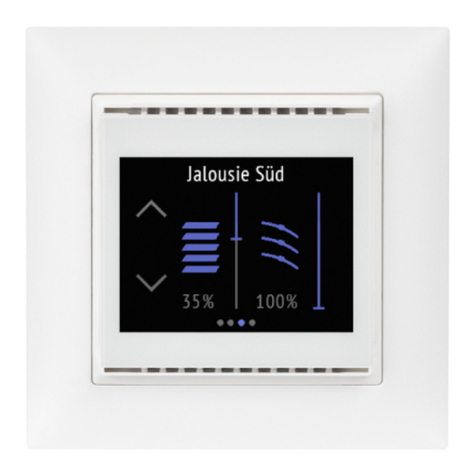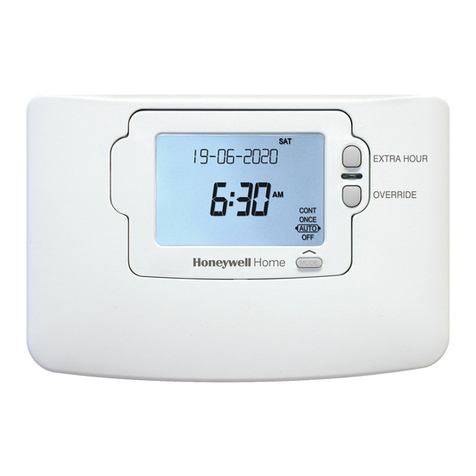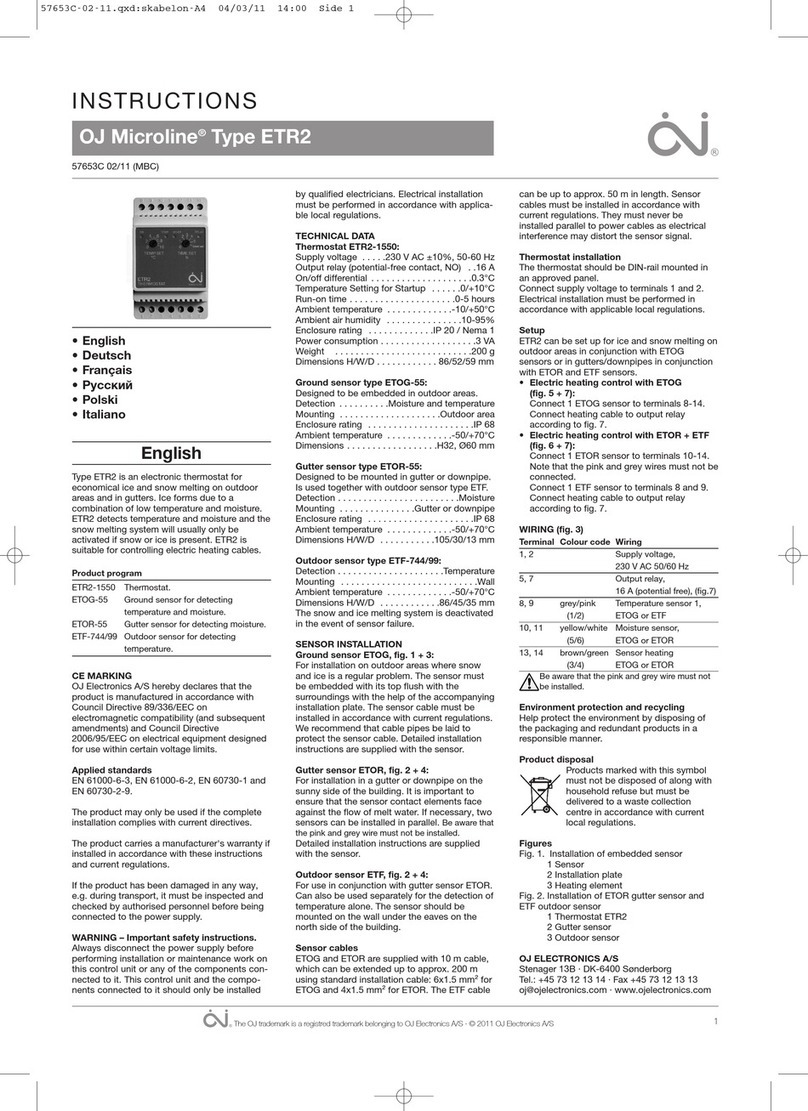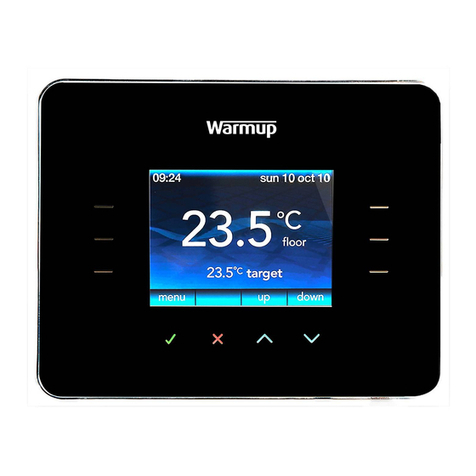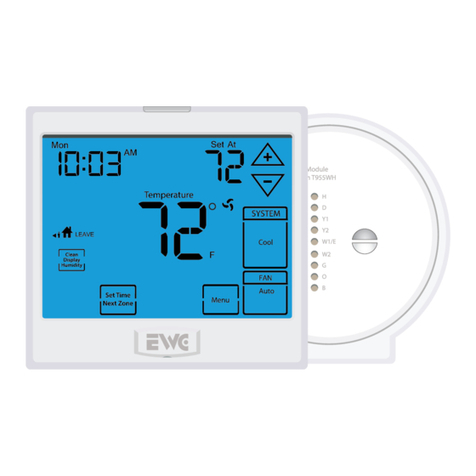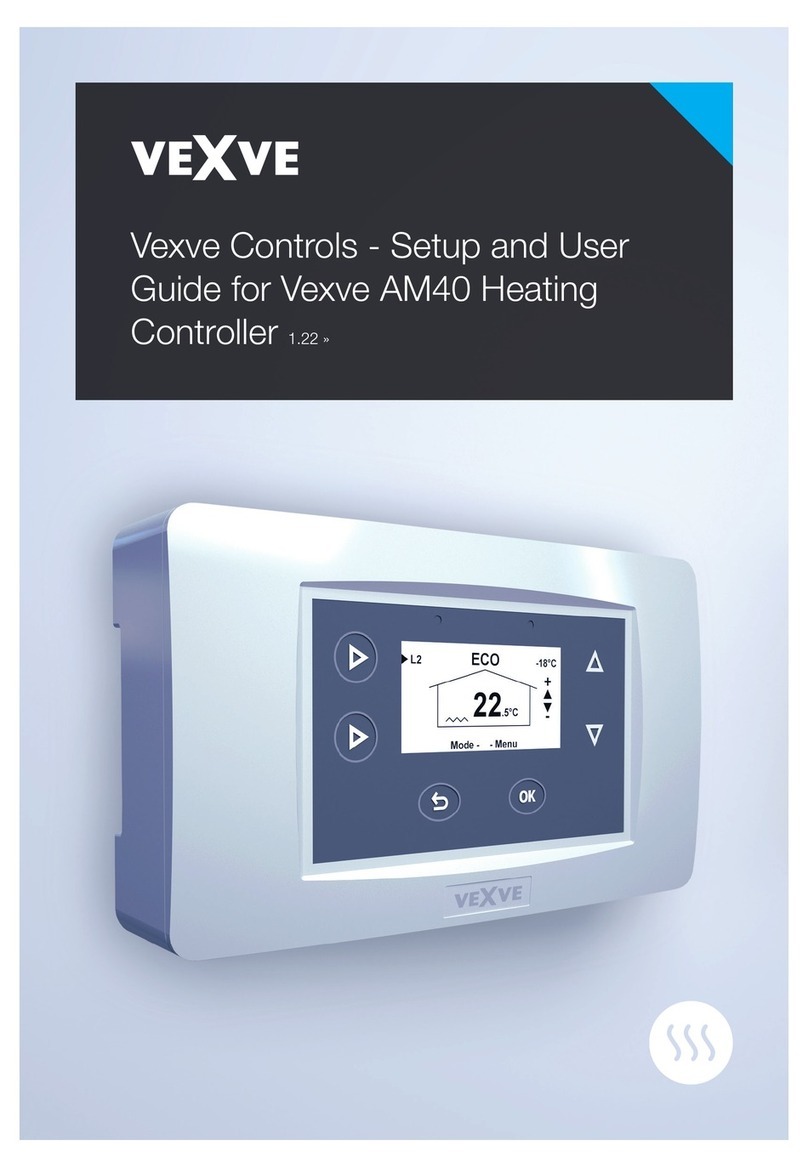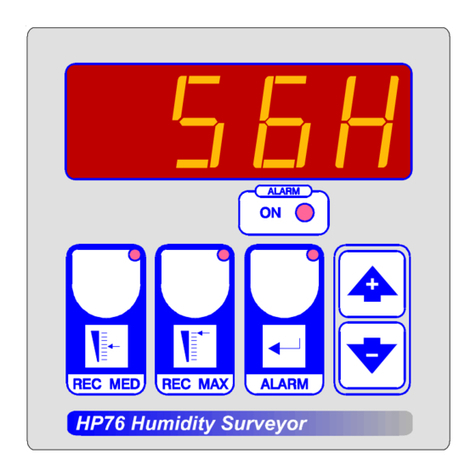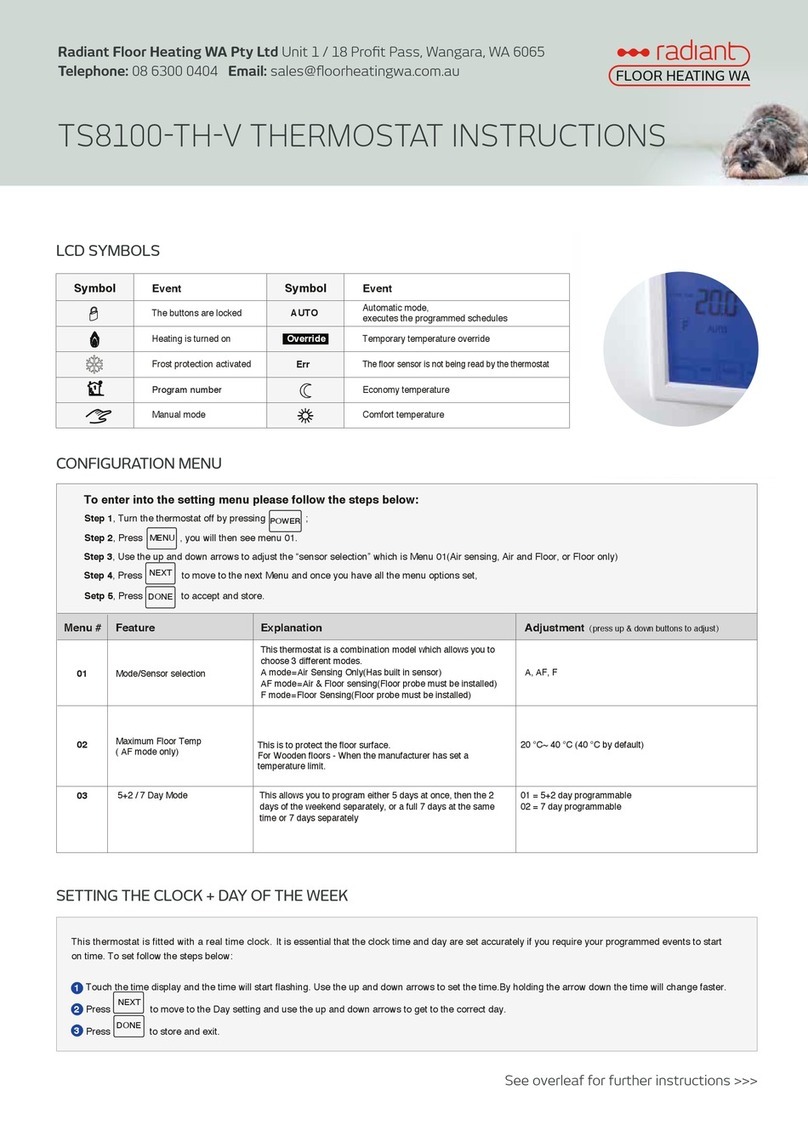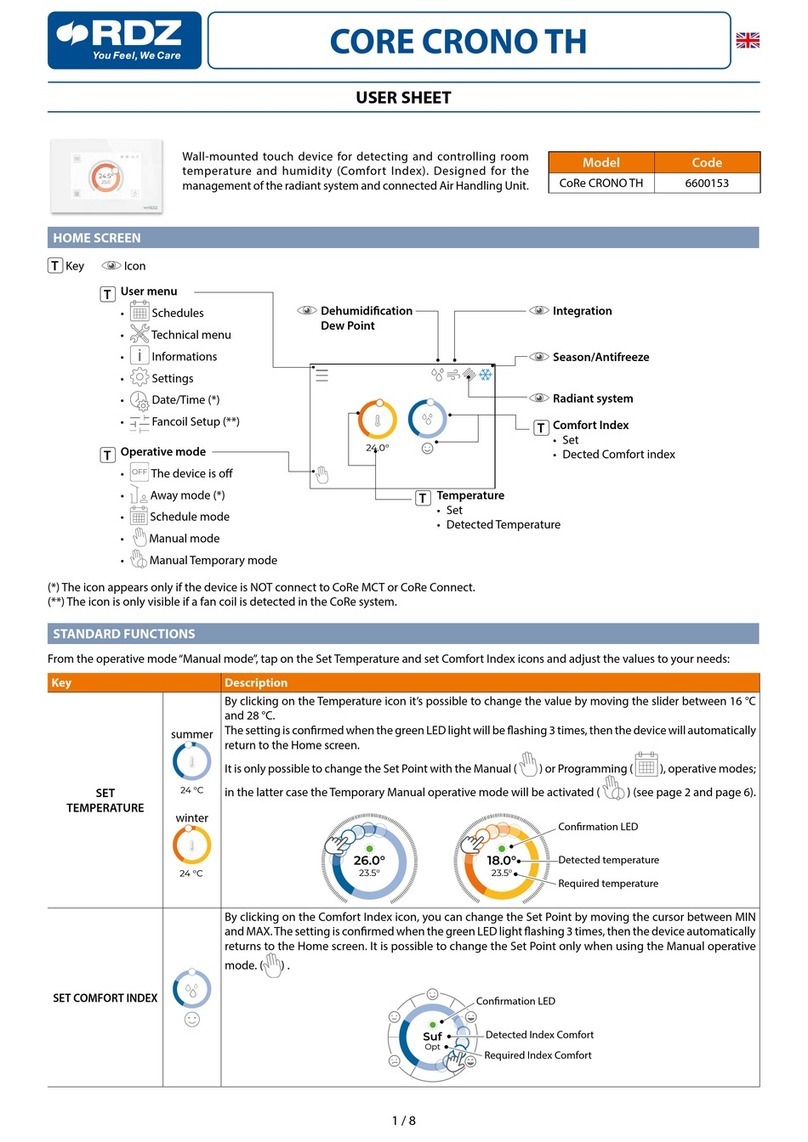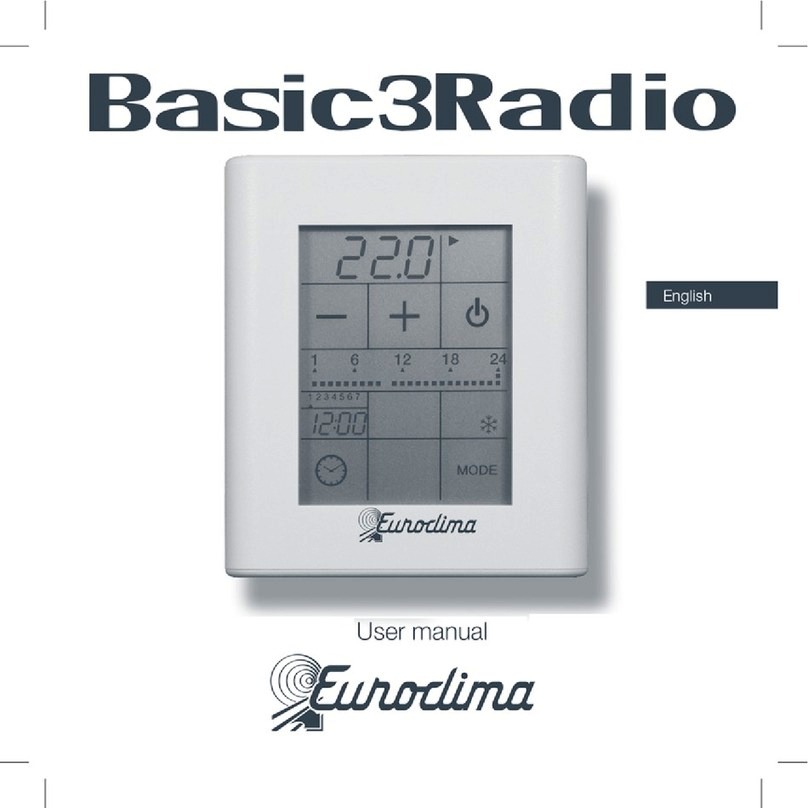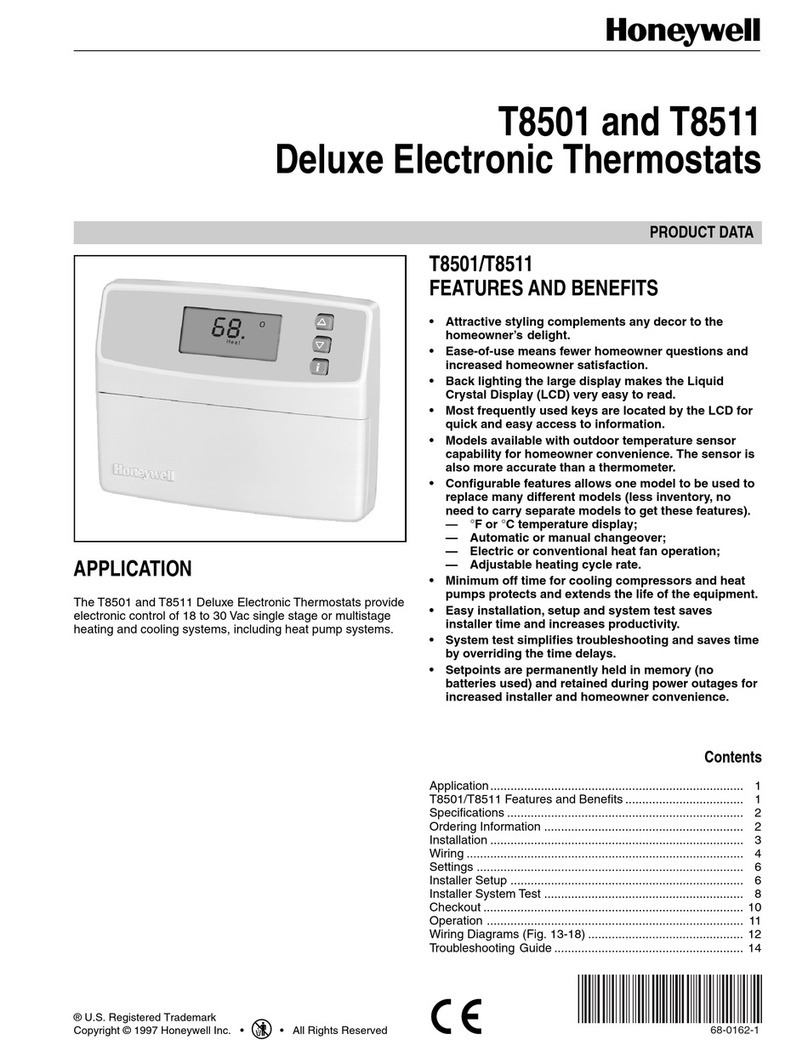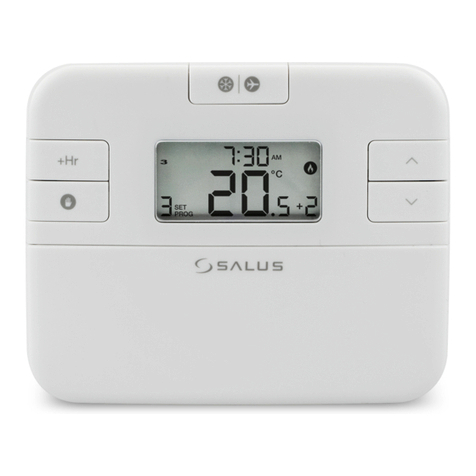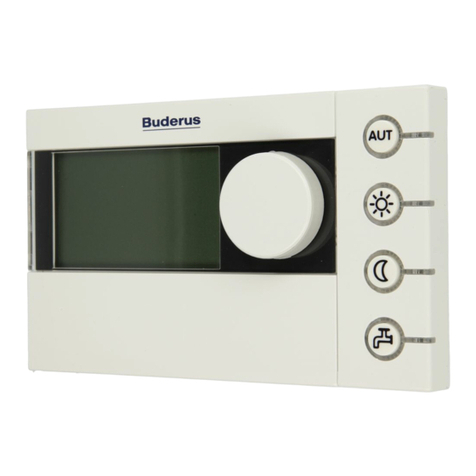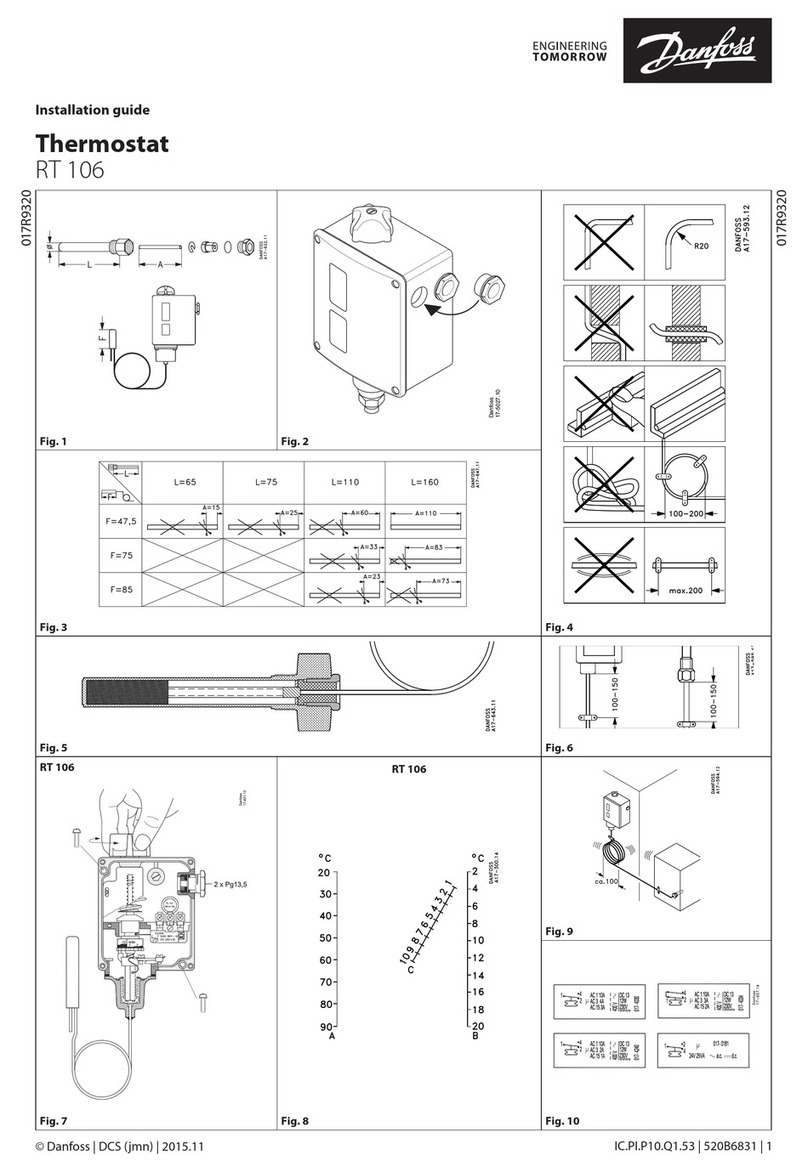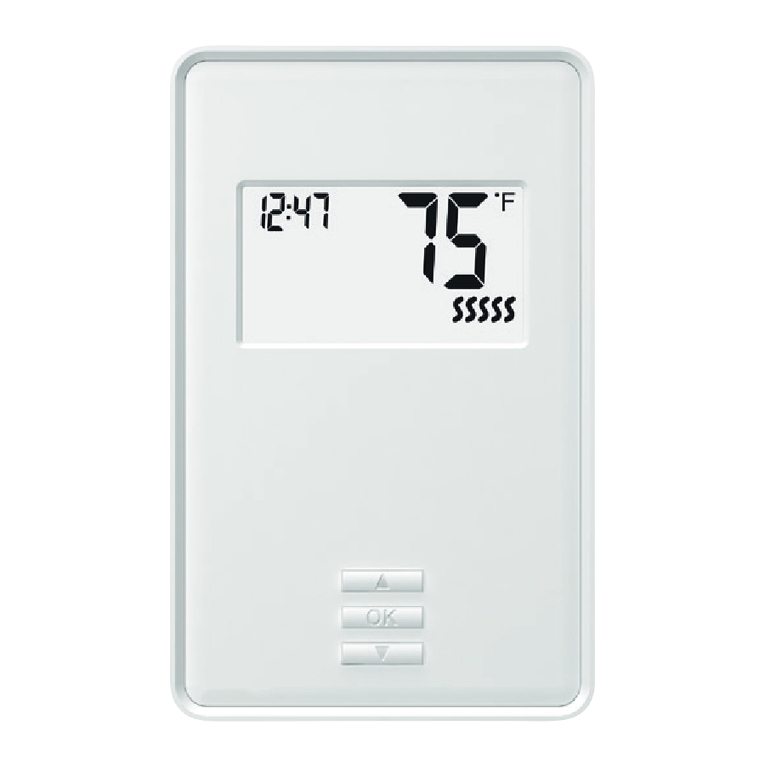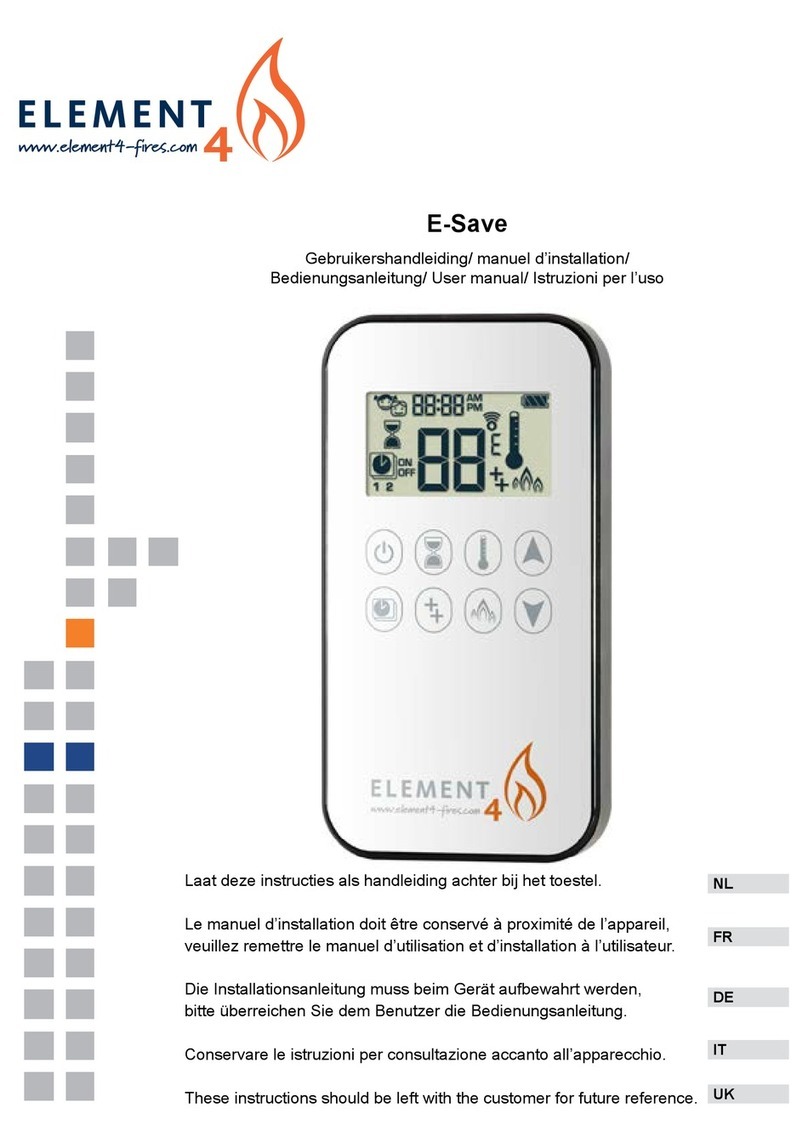Elsner KNX eTR 101 User manual

Room Temperature Controller KNX eTR 101 1
Room Temperature Controller KNX eTR 101 • Version: 29.07.2020 • Technical changes and errors excepted. • Elsner Elektronik GmbH • Sohlengrund 16 • 75395 Ostelsheim • Germany • www.elsner-elektronik.de • Technical Service: +49 (0) 7033 / 30945-250
EN
KNX eTR 101
Room Temperature Controller
1. Description
The Room Temperature Controller KNX eTR 101 measures the room tempera-
ture and displays the current value. Via the bus the device can receive an external
measured value and process it with own data to overall temperature value (mixed
value).
The KNX eTR 101 has got an integrated PI controller for a heating and a cooling
system (one or two step). The room temperature is adjusted by means of the + and
- touch buttons.
Functions:
• Measurement of temperature. Mixed value from own measured value and
external values (proportions can be set in percentage), output of minimum
and maximum values
•Display of the actual value or the target value/basic setpoint shift
•2 touch buttons (+/-) for adjustment of the room temperature
•PI controller for heating (one or two step) and cooling (one or two step)
depending on temperature. Control according to separate target values or
basic target temperature
Configuration is made using the KNX software ETS 5. The product file can be dow-
nloaded from the ETS online catalogue and the Elsner Elektronik website on
www.elsner-elektronik.de in the “Service” menu.
1.0.1. Scope of delivery
• Room temperature controller with mounting
• 4 screw anchors 4 × 20 mm, 4 flat head screws 3 × 25 mm
1.1. Technical specifications
The product conforms with the provisions of EU guidelines.
1.1.1. Accuracy of the measurement
Measurement variations from permanent sources of interference (see chapter Ins-
tallation position) can be corrected in the ETS in order to ensure the specified accu-
racy of the sensor (offset).
When measuring temperature, the self-heating of the device is compensated.
2. Installation and commissioning
2.1. Installation notes
Installation, testing, operational start-up and troubleshooting should
only be performed by an electrician.
CAUTION!
Live voltage!
There are unprotected live components inside the device.
• National legal regulations are to be followed.
• Ensure that all lines to be assembled are free of voltage and take
precautions against accidental switching on.
• Do not use the device if it is damaged.
• Take the device or system out of service and secure it against
unintentional use, if it can be assumed, that risk-free operation is
no longer guaranteed.
The device is only to be used for the intended purpose described in this manual. Any
improper modification or failure to follow the operating instructions voids any and
all warranty and guarantee claims.
After unpacking the device, check it immediately for possible mechanical damage.
If it has been damaged in transport, inform the supplier immediately.
The device may only be used as a fixed-site installation; that means only when as-
sembled and after conclusion of all installation and operational start-up tasks and
only in the surroundings designated for it.
Elsner Elektronik is not liable for any changes in norms and standards which may
occur after publication of these operating instructions.
2.2. Installation position
The Room Temperature Controller KNX eTR 101 is made for wall mounting.
The device can be mounted directly on plaster or on a socket (Ø 60 mm).
May be installed and operated in dry interior rooms only.
Avoid condensation.
When selecting an installation location, please ensure that the measurement results
are affected as little as possible by external influences. Possible sources of interfe-
rence include:
• Direct sunlight
• Drafts from windows and doors
• Draft from ducts which lead from other rooms or from the outside to the
junction box in which the sensor is mounted
• Warming or cooling of the building structure on which the sensor is mounted,
e.g. due to sunlight, heating or cold water pipes
• Connection lines and ducts which lead from warmer or colder areas to the
sensor
Measurement variations from permanent sources of interference can be corrected
in the ETS in order to ensure the specified accuracy of the sensor (offset).
2.3. Composition of the device
2.4. Mounting
Prepare the device
Remove the front panel from the mounting. Release the lock by moving the front pa-
nel a few millimetres upwards. The two parts can then be easily separated (Fig. 4).
Housing plastic material, glass
Colours • similar to RAL 9003 signal white
• similar to RAL 9005 jet black
Mounting on-wall (directly or with a socket Ø60 mm,
resp. cavity wall socket for hole Ø68 mm)
Degree of protection IP 10
Dimensions housing approx. 81,5 x 81,5 (W x H, mm),
mounting depth approx. 12 mm
Total weight approx. 65 g
Ambient temperature Operation 0…+55°C, storage -30…+85°C
Ambient air humidity 5...95% RH, avoid bedewing
Operating voltage KNX bus voltage
Bus current 10 mA at 50% LED brightness,
18 mA at 100% LED brightness
Data output KNX +/- bus terminals
Group addresses max. 254
Allocations max. 254
Communication objects 41
Temperature measure-
ment range
0…+55°C
Temperature resolution 0.1°C
Technical specifications and installation instructions
Item numbers 70650 (white), 70651 (black)
13
Fig. 1: Front view
1 Touch area -
2 Temperatur display
3 Touch area +
2
4
5
6
Fig. 2: Back view with mounting
4/5Screw holes for different sockets. Fas-
tening with 2 screws is sufficient. For
wall mounting, use a fixing material
suitable for the ground!
6 KNX bus terminal +/- for connection
when mounted on a socket
7 Spring-loaded terminals KNX bus for
mounting directly on the wall
4
44
55
5
7
Fig. 3: Back view without mounting
6 KNX bus terminal +/- for connection
when mounted on a socket
7 Spring-loaded terminals KNX bus for
mounting directly on the wall
8 Programming LED
9 Programming button (recessed) for
teaching device
10 Temperature sensor
PRG key is accessible from below/outside
when the device is mounted (see chapter
Addressing the device).
67910
8

Room Temperature Controller KNX eTR 101 2
Room Temperature Controller KNX eTR 101 • Version: 29.07.2020 • Technical changes and errors excepted. • Elsner Elektronik GmbH • Sohlengrund 16 • 75395 Ostelsheim • Germany • www.elsner-elektronik.de • Technical Service: +49 (0) 7033 / 30945-250
Screw the mounting onto the wall or socket. The connecting wires (bus line +/-) are
led through the opening in the mounting.
Installation directly on the wall
The wires are pushed into the connection openings.
Installation on a socket
To avoid falsifying the temperature value, use a wind-proof socket and also seal the
inlet pipes against draughts.
Finish mounting
Snap the front panel into place on the mounting (see Fig. 4): Place it slightly above
the centre position, hook it in and slide it downwards.
2.5. Notes on mounting and commissioning
Never expose the device to water (e.g. rain) or dust. This can damage the electro-
nics. You must not exceed a relative humidity of 95%. Avoid condensation.
After the bus voltage has been applied, the device will enter an initialisation phase
lasting a few seconds. During this phase no information can be received or sent via
the bus.
3. Addressing the device
The device is delivered ex works with the bus address 15.15.255. You program a dif-
ferent address in the ETS by overwriting the address 15.15.255 or teach the device
using the programming button.
The programming button is located at the bottom outer side of the front panel of the
device and is recessed. Use a thin object to reach the button, e. g. a 1.5 mm² wire.
4. Display and operation at the device
4.1. Adjust room temperature
Depending on the setting of the "Display mode" parameter in the device application,
the Room Temperature Controller KNX eTR 101 displays the current room
temperature value (or mixed value), the target value or the shift in relation to the
basic setpoint. The display can be dimmed and switched off via the bus so that no
value is displayed.
Option A: Display of actual temperature (room temperature)
The current room temperature is displayed. It is not possible to change the room
temperature manually using the +/- buttons.
Option B: Display of target temperature or basic setpoint shift
Depending on the setting, the current target value or the shift relative to the base
setpoint is displayed. The temperature can be changed by touching the +/- buttons.
Target value display (absolute value):
Display of the basic setpoint shift (change compared to the basic setpoint of the
control):
Option C: Display of actual temperature and target temperature/basic set-
point shift
During normal operation, the current room temperature is displayed. By touching
the buttons, the display jumps to the target temperature or to the basic setpoint
shift, depending on the presetting. Changes with + or - are visible. The display re-
turns to the room temperature if no button is touched for 7 seconds.
Touch the + or - button briefly: The current target temperature (or the basic set-
point shift) is displayed.
Tap +: Increase room temperature
(target temperature/basic setpoint shift is increased).
Tap -: Lower room temperature
(target temperature/basic setpoint shift is lowered).
General:
The step size for the change and the possible setting range are defined in the device
application (ETS). There you can also define whether the manually changed values
are retained after a mode change (e.g. Eco mode overnight) or reset to the stored
values.
The button functions can be locked due to operating mode with priority 1.
5. Maintenance and care
Fingerprints on the glass panel are best removed with a cloth moistened with water
or a microfiber cloth. Do not use an abrasive cleaning agent or aggressive cleansing
agents.
6. Disposal
After use, the device must be disposed of or recycled in accordance with the legal
regulations. Do not dispose of it with the household waste!
Fig. 4 Locking of front panel and mounting
Remove the red-black KNX bus terminal, it
is not required.
Connect the bus +/- connecting wires to the
spring-loaded terminals on the front panel.
Fig. 5 Spring-loaded terminals
To pull it out, press the spring down, e.g.
with a screwdriver.
If there is a cavity behind the device, e.g.
when using a socket, you can use the red/
black KNX bus terminal for connection.
PRG
Fig. 6
View from bottom
Temperature sensor
Tap +:
Increase room temperatu-
re
(target temperature is in-
creased)
Tap -:
Lower room temperature
(target temperature is lo-
wered)
Tap +:
Increase room temperatu-
re
(Basic setpoint shift direc-
tion PLUS)
Tap -:
Lower room temperature
(Basic setpoint shift direc-
tion MINUS)
or
Other manuals for KNX eTR 101
1
This manual suits for next models
2
Other Elsner Thermostat manuals
